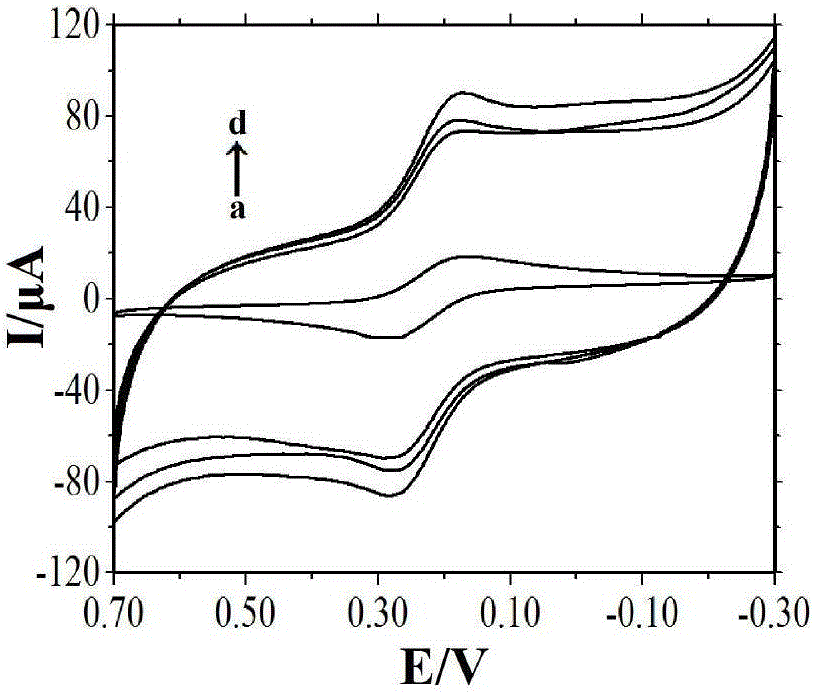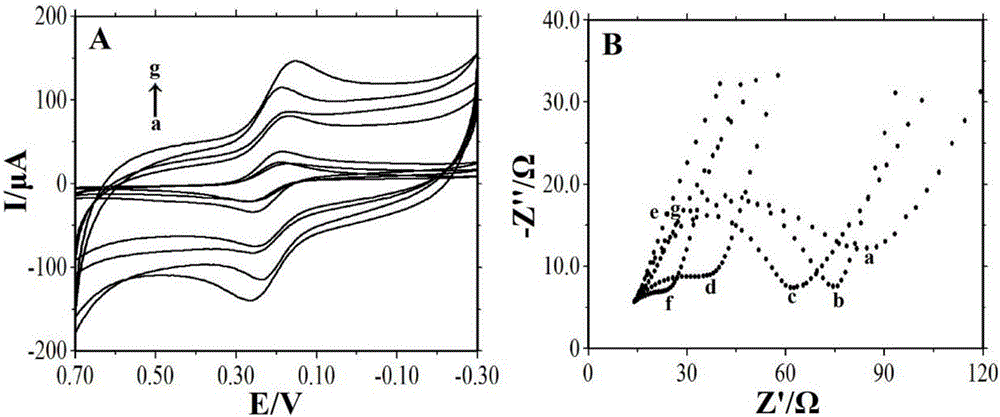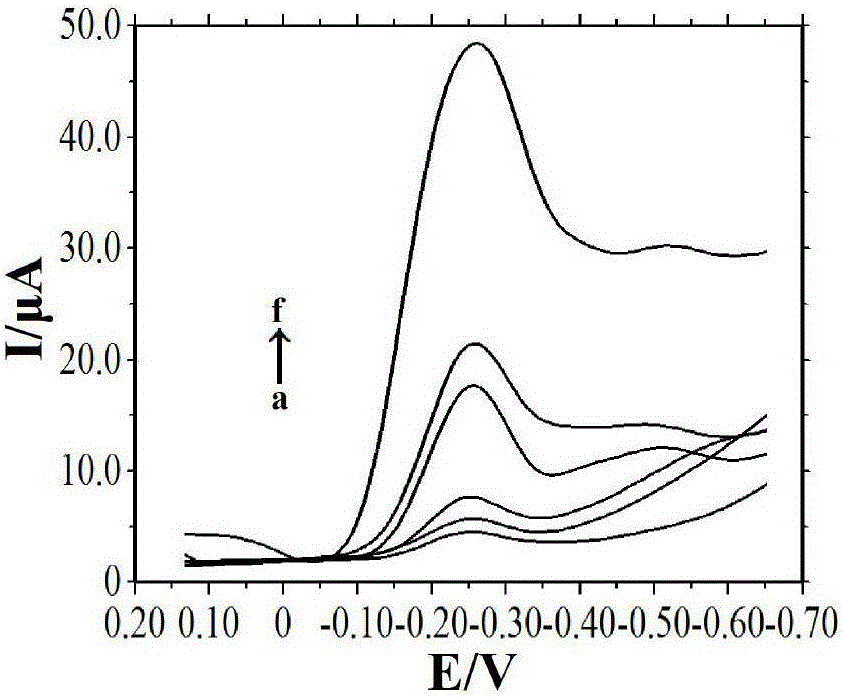Preparation and application method of electrochemical reduction graphene oxide and nanogold modified electrode based DNA sensor
A technology for modifying electrodes and graphene. It is applied to electrochemical variables of materials, instruments, scientific instruments, etc. It can solve problems such as affecting the sensitivity of electrochemical sensors, and achieve the effect of easy surface, convenient use and good conductivity.
- Summary
- Abstract
- Description
- Claims
- Application Information
AI Technical Summary
Problems solved by technology
Method used
Image
Examples
Embodiment 1
[0033] The preparation method of embodiment 1 DNA sensor
[0034] (1) Accurately weigh 1.6g of graphite powder and 0.8g of HPPF with an electronic balance 6 , the weighed graphite powder and HPPF 6 Put it in an agate mortar and grind it evenly to get the ionic liquid modified carbon paste, then slowly fill the ionic liquid modified carbon paste into a glass tube with a length of 6cm and an inner diameter of 4mm for compaction, and insert a thin copper wire as a wire , to obtain the ionic liquid modified carbon paste electrode (CILE), which was polished to a mirror surface on a clean polishing paper before use.
[0035] (2) Accurately weigh a certain mass of HAuCl with an electronic balance 4 with NaNO 3 , dissolved in 50ml double-distilled water, ultrasonically dispersed evenly, that is, 3.0mmol / LHAuCl 4 and 0.1mol / L NaNO 3 mixture. With CILE as the working electrode, platinum as the auxiliary electrode, and a saturated calomel electrode as the reference electrode, gold ...
Embodiment 2
[0039] The electrochemical characterization of embodiment 2DNA sensor
[0040] The surface of different modified electrodes was characterized by cyclic voltammetry and AC impedance method, the results are as follows figure 2 shown. 10.0μL of PBS buffer solution (50.0mmol / L, pH=7.0) containing the target sequence was directly drop-coated on the surface of ssDNA / p-RGO / AuNPs / CILE, and hybridized at room temperature with 0.5% SDS solution and twice Rinse with distilled water to remove unhybridized target sequences, and the electrode after hybridization is denoted as dsDNA / p-RGO / AuNPs / CILE.
[0041] For the results of cyclic voltammetry, see figure 2 A, the electrolyte is 1.0mmol / LK 3 [Fe(CN) 6 ] and 0.5mol / L KCl, the platinum sheet was used as the auxiliary electrode, and the saturated calomel electrode was used as the reference electrode. Different modified electrodes (GO / AuNPs / CILE, CILE, AuNPs / CILE, dsDNA / p-RGO / AuNPs / CILE, p-RGO / CILE, ssDNA / p-RGO / AuNPs / CILE and p-RGO / Au...
Embodiment 4
[0045] The detection of embodiment 4 sensor selectivity
[0046] On the prepared sensor, 10.0 μL containing non-complementary sequence (5'-CATGTACGTTGCGCCAAGTAGT-3'); three-base mismatch sequence (5'-TG T AGTGACA G ATGTGCCGC A A-3'); single base mismatch sequence (5'-TGCAGTGACA G ATGTGCCGCCA-3') and the PBS buffer solution (50.0mmol / L, pH=7.0) of the target sequence were directly drip-coated on the surface of ssDNA / p-RGO / AuNPs / CILE, and after hybridization at room temperature, they were mixed with 0.5% SDS solution and Rinse with double distilled water to remove unhybridized target sequences, and then in 2.0×10 -5 Soak in the methylene blue solution of mol / L concentration for 8 minutes, take it out, wash it with 0.5% SDS solution and secondary water successively, and detect the current of the sensor by differential pulse voltammetry, the results are shown in Figure 4 . The electrolyte was 50.0mmol / LTris-HCl buffer solution, the platinum sheet was used as the auxiliary el...
PUM
| Property | Measurement | Unit |
|---|---|---|
| concentration | aaaaa | aaaaa |
Abstract
Description
Claims
Application Information
 Login to View More
Login to View More - R&D
- Intellectual Property
- Life Sciences
- Materials
- Tech Scout
- Unparalleled Data Quality
- Higher Quality Content
- 60% Fewer Hallucinations
Browse by: Latest US Patents, China's latest patents, Technical Efficacy Thesaurus, Application Domain, Technology Topic, Popular Technical Reports.
© 2025 PatSnap. All rights reserved.Legal|Privacy policy|Modern Slavery Act Transparency Statement|Sitemap|About US| Contact US: help@patsnap.com



